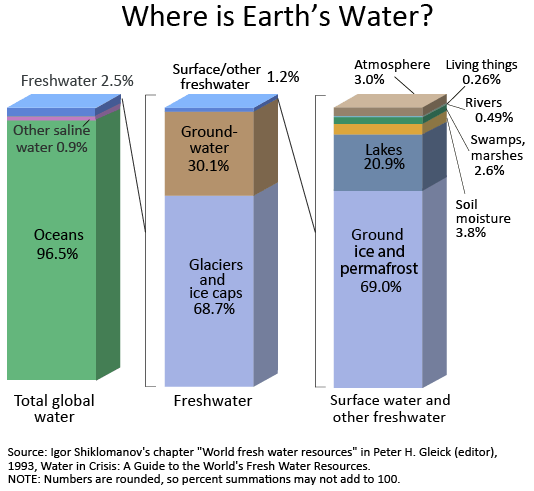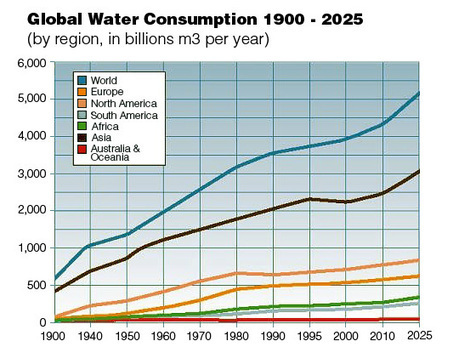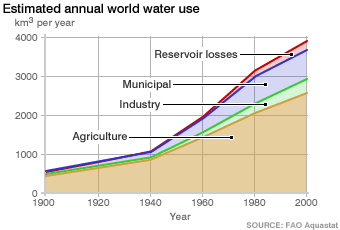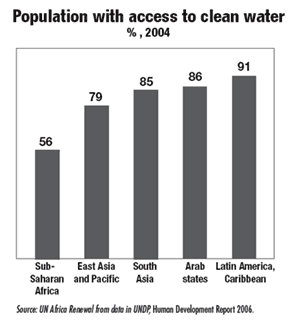Water and change

Source: http://water.usgs.gov/edu/earthwherewater.html
Water use

Source: http://www.scoop.it/t/apes-water-ownership-awesome/p/2917959986/2012/10/08/water-usage-graph-world-continents-jpg-540x428-pixels

Source: http://graphs.net/water-usage-graph.html

Source: http://www.englishadvantage.info/lesson/ielts-task-1/
Water use in India

Source: https://env3400spring2013india.wordpress.com/2013/04/18/water-use-by-industry/

Source: http://envirosupply.net/blog/water-usage-by-industries-worldwide-interesting-facts-and-figures
Water scarsity
Physical water scarsity: Lack of available water where water resource development is approaching or has exceeded unsustainable levels; it relates availability to demand and implies that arid areas are not necessarily water scarse. It is where water consumption exceedes 60% of the usable supply. To help meet water needs, some countries such as Saudi Arabia and Kwait have to import much of their food and invest on desalinisations plants.
Economic water scarsity: Lack of water where water is available locally, but not accessible for human, institutional or financial capital reasons. It is where a country phisically has sufficient water to meet its needs, but requires additional storage and transport facilities. This means having to embark on large and expensive water development projects, as in many sub-Saharan countries.
Source: Nagle, Garrett and Briony Cooke. Geography Course Companion. Oxford. Print.

Source: http://greenfieldgeography.wikispaces.com/Water+and+change
Causes of water shortage
Population Growth: As with many of the world's resources, they are coming under increasing pressure as the world's population grows. The world's population now stands at about 7 billion, all of whom are placing increasing on water resources as they develop and get richer.
Pollution: As the world's population grows so does the demand for agricultural and industrial products. Our thirst for agricultural products is increasing the use of fertilisers and pesticides which often run off into rivers and lakes or leach down to groundwater stores. Like wise our increasing demand for industrial and at times relaxed environmental regulations mean more chemicals and metals are being released into our water sources. Sewage treatment also often lags behind population growth so increasingly our rivers and lakes are being polluted by sewage.
Domestic Demand: The demand from households is not only increasing because there are more households in the world, but also because the amount of water they want is increasing with development. For example as peoples income increases and they move into permanent residences, they demand flush toilets, bath/showers, washing machines, dishwashers and green gardens, all of which use large amounts of water.
Agricultural Demand: As can be seen in the graph below, agricultural places by far the biggest demand on water. With a growing population, global warming and the movement in to less favourable agricultural regions, the demand from agriculture is only likely to increase in the future.
Industrial Demand: As the world's population grows and becomes richer our demand for industrial products grows. Many industrial products, particular things like processing metal use huge quantities of water and place increasing demand on resources. Also mining for the raw materials used in manufacturing use large quantities of water.
Sewage: With rapid urbanisation taking place in many cities around the world, infrastructure often does not keep up with new arrivals. The growth of informal settlements without proper sewage treatment can mean that human waste is often pumped directly into water sources. However, this is not only a problem in LEDCs, in London the sewer system can not cope and an estimated 39 million tonnes of sewage are dumped in the River Thames annually.
Climate Change: Climate change is impacting the availability of water in many ways. Global warming maybe releasing freshwater from glaciers and ice shelves,but unfortunately much of it is running directly into the oceans. The subsequent rising sea levels are threatening many coastal freshwater wetlands as well as increasing the risk of saltwater intrusion into aquifers. Warmer temperatures are increasing the amount of evaporation from rivers and surfaces stores.
Political: In many countries or regions, water sources are shared e.g. the River Nile flows through eleven countries. At times some countries control large percentages of the shared resource, leading to shortages for other countries.
Mismanagement: If water is not used sustainably or inappropriately then water shortages can occur. One of the most famous examples is the Aral Sea. The Aral Sea is located on the border of Kazakhstan and Uzbekistan. Water was taken from the two rivers that fed the Aral Sea to irrigate the desert and grow cotton. Unfortunately so much water was needed to grow cotton in the desert, that no water reached the Aral Sea and it began to dry up, causing huge water shortages.
Groundwater Depletion: If water is used unsustainably i.e. more is taken out than is being recharged then aquifers can suffer from salinisation and saltwater intrusion. If you increase the concentration of water it can become too salty for human use. Also if you drain aquifers near coastal areas, then they can become full of saltwater, again making them useless.
Energy Production: Although HEP is the most obvious form of energy that uses water, this water is released into rivers once it has passed through the dam. Other types of energy that uses large amount of water for cooling e.g. coal and nuclear power, may pollute water or see it evaporated removing it from local use.
Source: http://greenfieldgeography.wikispaces.com/Water+and+change
Factors affecting access to safe drinking water

Source: http://www.un.org/africarenewal/magazine/october-2007/bringing-water-africa%E2%80%99s-poor

Source: http://mcleankids.wikifoundry.com/page/Lesson+3+Examine+the+Factors+Affecting+Safe+Access+to+Drinking+Water
- Increasing population
- Absense of management and regulation in regards to industrial and domestic waste disposal
- Problems of lack of maintenance in the pipes
- Little or lack of investiments in infrastructure for storage and transport
- Over use of water sources and supply mechanisms
- Point source pollution (e.g. oil spills)
- Solid waste disposal
- Septic tanks
- Difuse pollution from agricultural activity
Source: https://prezi.com/o-zeeohuzduq/examine-the-factors-affecting-access-to-safe-drinking-water/

No comments:
Post a Comment